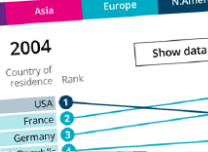Employment and labour market
Regional labour market statistics in the UK: May 2017
For the 3 months ending March 2017, the highest employment rate in the UK was in the South West (78.7%) and the lowest was in Northern Ireland (68.4%).
For the 3 months ending March 2017, the highest unemployment rate in the UK was in London (6.1%) and the lowest was in the South East (3.5%).
For the 3 months ending March 2017, the highest economic inactivity rate in the UK was in Northern Ireland (27.7%) and the lowest was in the South West (18.2%).
UK productivity flash estimate: Jan to Mar 2017
Output per hour – our main measure of labour productivity – fell by 0.5% in Quarter 1 (January to March) 2017. This compares with growth of 0.4% in Quarter 4 (October to December) 2016, as published in the April 2017 Productivity Bulletin and as presented in Figure 1.
The fall in productivity in Quarter 1 was the result of slower gross value added (GVA) growth (using the preliminary gross domestic product (GDP) estimate) combined with an increase in total hours worked driven by growth in both employment and average weekly hours worked (using the latest Labour Force Survey data).
The UK employment rate reached a new record high of 74.8% in the 3 months to March 2017 on the back of recent increases in full time employment.
The unemployment rate dropped to 4.6% in the 3 months to March 2017, down from 5.1% a year earlier, and is now at its lowest since 1975.
The number of vacancies increased by 3% in the 3 months to April 2017 to 777,000, the highest level on record.
UK labour market statistics: May 2017
Estimates from the Labour Force Survey show that, between October to December 2016 and January to March 2017, the number of people in work increased, the number of unemployed people fell, and the number of people aged from 16 to 64 not working and not seeking or available to work (economically inactive) also fell.
There were 31.95 million people in work, 122,000 more than for October to December 2016 and 381,000 more than for a year earlier.
The employment rate (the proportion of people aged from 16 to 64 who were in work) was 74.8%, the highest since comparable records began in 1971.
|






